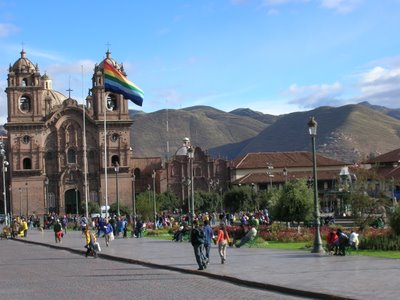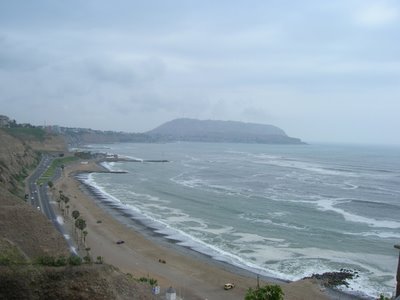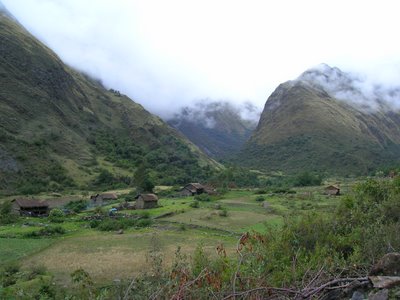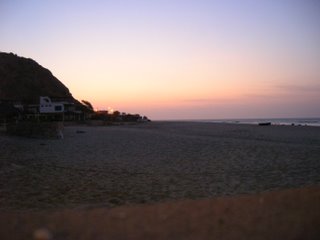Our visit to Chilcatotoras
 On our second day in Cuenca we splurged on a full day cultural tour of an indigenous community, known as Chilca Tototas, 40 minutes south of town. For 30 dollars each we spent the day with a group of mostly women (as the men now work construction in town) who taught us about typical food, medicinal plants, farming, construction techniques, and for lunch a feast! To the left of me, is Blanca our spanish speaking guide, here Michelle with her spanish skills saved the day.
On our second day in Cuenca we splurged on a full day cultural tour of an indigenous community, known as Chilca Tototas, 40 minutes south of town. For 30 dollars each we spent the day with a group of mostly women (as the men now work construction in town) who taught us about typical food, medicinal plants, farming, construction techniques, and for lunch a feast! To the left of me, is Blanca our spanish speaking guide, here Michelle with her spanish skills saved the day. They have all types of livestock; sheep, goats, horses, giant pigs, and even guinea pigs. They use the milk cows to produce cheese in a small factory that a group of French Doctors helped build.
They have all types of livestock; sheep, goats, horses, giant pigs, and even guinea pigs. They use the milk cows to produce cheese in a small factory that a group of French Doctors helped build.
 The tour even included a horseback ride! A natural gaucho. On another note, most adults wear the famous Panama hats or straw hats. Cuenca, happens to be the world supplier of such hats as well.
The tour even included a horseback ride! A natural gaucho. On another note, most adults wear the famous Panama hats or straw hats. Cuenca, happens to be the world supplier of such hats as well.
 The best part of this story is of course the roast guinea pig. First they broke the little guys neck and then popped out an eye to drain the blood. After which, with some excitement we discovered the guinea pig was still alive, so another round of neck breaking. Next the guinea pig went in a pot of boiling water in order to make it easier to defur him. Which is where Alex took over, with some quality roasting. At the time Alex thought this was pretty cool, but after eating the guinea pig for lunch and a few days of sickness, the picture now makes him a bit nauseous.
The best part of this story is of course the roast guinea pig. First they broke the little guys neck and then popped out an eye to drain the blood. After which, with some excitement we discovered the guinea pig was still alive, so another round of neck breaking. Next the guinea pig went in a pot of boiling water in order to make it easier to defur him. Which is where Alex took over, with some quality roasting. At the time Alex thought this was pretty cool, but after eating the guinea pig for lunch and a few days of sickness, the picture now makes him a bit nauseous.
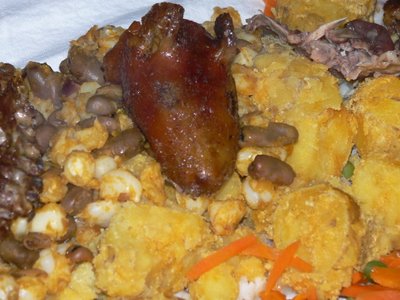 In spanish guinea pig is known as cuy. Here is the head on a bed of potatoes, corn, rice, carrots, and chicken. Poor little guy. Guinea pig is a delicacy at the feast, the best part of the whole meal! I did not eat the head, but the belly was pretty good, tastes a bit like chicken, but doesn´t everything?
In spanish guinea pig is known as cuy. Here is the head on a bed of potatoes, corn, rice, carrots, and chicken. Poor little guy. Guinea pig is a delicacy at the feast, the best part of the whole meal! I did not eat the head, but the belly was pretty good, tastes a bit like chicken, but doesn´t everything?
 The feast. Eaten on the floor in the mud walled house. The community is in the process of the converting this room into a cabana or cabin for turists to sleep in. Very cool. The feast was fun too, I was the only one to use silverware.
The feast. Eaten on the floor in the mud walled house. The community is in the process of the converting this room into a cabana or cabin for turists to sleep in. Very cool. The feast was fun too, I was the only one to use silverware.
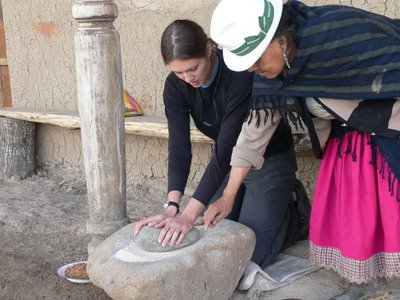 After lunch we rested. Seriously. Our bellies were huge. Then we learned how to make wheat flour from wheat chaff. Its hard work! We tried some mixed in coffee and it was pretty good. Michelle also helped plant potatoes with a mixture of horse manure and guinea pig feces as fertilizer. A step back in time, needless to say we learned a lot.
After lunch we rested. Seriously. Our bellies were huge. Then we learned how to make wheat flour from wheat chaff. Its hard work! We tried some mixed in coffee and it was pretty good. Michelle also helped plant potatoes with a mixture of horse manure and guinea pig feces as fertilizer. A step back in time, needless to say we learned a lot.

















